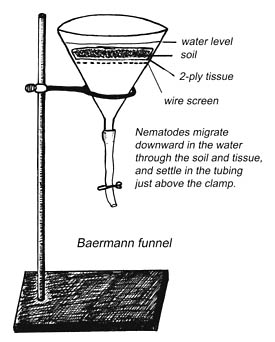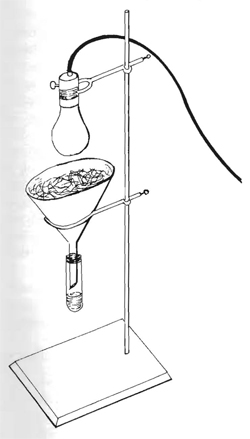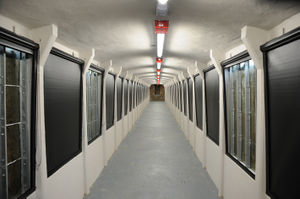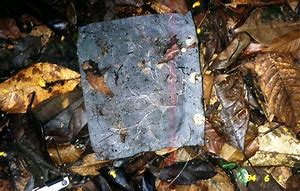Soil Sampling Methods: Difference between revisions
m The LinkTitles extension automatically added links to existing pages (<a rel="nofollow" class="external free" href="https://github.com/bovender/LinkTitles">https://github.com/bovender/LinkTitles</a>). |
No edit summary |
||
| Line 1: | Line 1: | ||
[[File:Baermann funnel.jpg|thumb|Baermann Funnel]] | [[File:Baermann funnel.jpg|thumb|Baermann Funnel]] | ||
[[Soil]] | [[Soil]] sampling gives is useful for determining the structure and function of the [[soil|soil]] community. We can measure things like, what kind of [[organisms|organisms]] are living in the soil, the [[plant roots|plant roots]] structure, leaf litter break down and [[decomposition]]. There are different methods of soil sampling, for different types of [[organisms]] you are trying to extract. As well as different methods for measuring variables you are trying to observe like decomposition. | ||
== Baermann Funnel == | == Baermann Funnel == | ||
Baermann funnels are useful for measure nematode abundance and richness in a soil sample. A funnel with a small mesh or muslin lining on the inside. There is a tube attached to the bottom of the funnel, which is clamped shut at the bottom. When the soil is placed in the funnel you fill up the funnel to the rim with water. This water pushes the [[small creaters|small creaters]] through the filter into the bottom of the tube. Organisms like [[nematodes|nematodes]] will also swim down through the soil and water, through the mesh and into the bottom of the tube. After it sets for 24 to 48 hours, so all the [[organisms|organisms]] have time to filter down to the bottom. Then we open the clamp and allow the organism to drain into a petri dish. We can take the petri dish under a microscope and look for the [[microorganisms|microorganisms]] that were living in the soil. | |||
[[File:Berlese funnel.jpg|thumb|Berlese/Tullgren Funnel]] | [[File:Berlese funnel.jpg|thumb|Berlese/Tullgren Funnel]] | ||
| Line 15: | Line 15: | ||
== Berlese/Tullgren Funnel == | == Berlese/Tullgren Funnel == | ||
Leaf litter samples are typically placed in Berlese-Tullgren funnels to sample for soil micro- and mesofauna.The Berlese-Tullgren apparatus consists of a funnel, a light source, a screen, and a receptacle into which the [[animals]] fall. The sample is placed in a funnel that is lined with a screen with the light source above; the extraction process works by desiccating the soil from above via heat lamp, forcing the fauna downward through the funnel into the sampling liquid below. Organisms one may capture via this method include [[arthropods]] like, [[insects|insects]], [[myriapoda|myriapoda]], and crustaceans. | |||
---- | ---- | ||
| Line 22: | Line 21: | ||
== Leaf Litter Pack == | == Leaf Litter Pack == | ||
In a leaf litter pack you fill a mesh bag, usually a small 1/4 inch opening, with leaves and lettuce. The size in the mesh is varying depending on the size of [[organisms|organisms]] you are looking to catch. The mesh has to be large enough so they can crawl into the bag, and small enough so they do not fall out. When picking where you want to place the leaf pack you want to find a low spot on the ground, as this is where there is the most organisms living. This is where the most fertile soil is, and where the moisture content is highest. You dig a small hole in the ground, place the bag in the hole and cover it up with the [[soil|soil]] and surrounding leaves. Then, place a flag sticking out of the ground next to the bag so you can find it later. Let the leaf pack sit for a couple days to allow organisms to get into the bag before you remove it. Next, you dump the leaves out of the bag onto a plate and start looking for organisms like slugs, worms, centipedes, [[mites]], and smaller organisms. You can put them on a petri dish and observe the [[soil organisms|soil organisms]] closer under the microscope to allow you to properly identify them. | In a leaf litter pack you fill a mesh bag, usually a small 1/4 inch opening, with leaves and lettuce. The size in the mesh is varying depending on the size of [[organisms|organisms]] you are looking to catch. The mesh has to be large enough so they can crawl into the bag, and small enough so they do not fall out. When picking where you want to place the leaf pack you want to find a low spot on the ground, as this is where there is the most organisms living. This is where the most fertile soil is, and where the moisture content is highest. You dig a small hole in the ground, place the bag in the hole and cover it up with the [[soil|soil]] and surrounding leaves. Then, place a flag sticking out of the ground next to the bag so you can find it later. Let the leaf pack sit for a couple days to allow organisms to get into the bag before you remove it. Next, you dump the leaves out of the bag onto a plate and start looking for organisms like [[slugs]], worms, centipedes, [[mites]], and smaller organisms. You can put them on a petri dish and observe the [[soil organisms|soil organisms]] closer under the microscope to allow you to properly identify them. | ||
[[File:Leaf litter pack.jpg|left thumb|Leaf litter pack ready to be burried]] | [[File:Leaf litter pack.jpg|left thumb|Leaf litter pack ready to be burried]] | ||
Revision as of 13:25, 5 May 2021

Soil sampling gives is useful for determining the structure and function of the soil community. We can measure things like, what kind of organisms are living in the soil, the plant roots structure, leaf litter break down and decomposition. There are different methods of soil sampling, for different types of organisms you are trying to extract. As well as different methods for measuring variables you are trying to observe like decomposition.
Baermann Funnel
Baermann funnels are useful for measure nematode abundance and richness in a soil sample. A funnel with a small mesh or muslin lining on the inside. There is a tube attached to the bottom of the funnel, which is clamped shut at the bottom. When the soil is placed in the funnel you fill up the funnel to the rim with water. This water pushes the small creaters through the filter into the bottom of the tube. Organisms like nematodes will also swim down through the soil and water, through the mesh and into the bottom of the tube. After it sets for 24 to 48 hours, so all the organisms have time to filter down to the bottom. Then we open the clamp and allow the organism to drain into a petri dish. We can take the petri dish under a microscope and look for the microorganisms that were living in the soil.

Berlese/Tullgren Funnel
Leaf litter samples are typically placed in Berlese-Tullgren funnels to sample for soil micro- and mesofauna.The Berlese-Tullgren apparatus consists of a funnel, a light source, a screen, and a receptacle into which the animals fall. The sample is placed in a funnel that is lined with a screen with the light source above; the extraction process works by desiccating the soil from above via heat lamp, forcing the fauna downward through the funnel into the sampling liquid below. Organisms one may capture via this method include arthropods like, insects, myriapoda, and crustaceans.
Leaf Litter Pack
In a leaf litter pack you fill a mesh bag, usually a small 1/4 inch opening, with leaves and lettuce. The size in the mesh is varying depending on the size of organisms you are looking to catch. The mesh has to be large enough so they can crawl into the bag, and small enough so they do not fall out. When picking where you want to place the leaf pack you want to find a low spot on the ground, as this is where there is the most organisms living. This is where the most fertile soil is, and where the moisture content is highest. You dig a small hole in the ground, place the bag in the hole and cover it up with the soil and surrounding leaves. Then, place a flag sticking out of the ground next to the bag so you can find it later. Let the leaf pack sit for a couple days to allow organisms to get into the bag before you remove it. Next, you dump the leaves out of the bag onto a plate and start looking for organisms like slugs, worms, centipedes, mites, and smaller organisms. You can put them on a petri dish and observe the soil organisms closer under the microscope to allow you to properly identify them.
Rhizotron

A rhizotron is a tunnel built under ground with windows placed all around the tunnel so you can observe the root and organisms interact. The roots from the plants above will grow down eventually hit and grow past the Rhizotron. As a result, the roots grow up to the windows which allows us to see the way the roots grow. We can see the roots along with the root hairs that grow off the roots. Using this method we can see how thick roots are, how deep they go and how wide spread the roots grow for different plants in different soil types. Using a rhizotron is very useful in a forest for research as scientists can measure and observe the interactions that occur on and around the roots. From the roots holding down the tree or other plants, to the interactions with the micro organisms living next to the root hairs. Scientists can learn a lot for using a rhizotron in a way that they do not have to dig up all the roots to see how they look and work. They can also observe Nutrient Cycling within forest ecosystems from within the soil.
References
Bug Hunter, bughunter.tamu.edu/collection/collectionequipment/berlese-funnel/.
“What Is a Rhizotron?” Effects of Emerald Ash Borer on Forest Ecosystems - Emerald Ash Borer - Forest Disturbance Processes - Northern Research Station - USDA Forest Service, www.nrs.fs.fed.us/research/facilities/rhizotron/.
“Berlese Funnels - Collecting Methods - Mississippi Entomological Museum Home.” Camponotus(Tanaemyrmex) Castaneus (Latreille) , mississippientomologicalmuseum.org.msstate.edu/collecting.preparation.methods/Berlesefunnel.htm#.WvLuxUxFzIV.
“Proper Soil Sampling Techniques.” Volusia County, www.volusia.org/services/community-services/extension/agriculture/proper-soil-sampling-techniques.stml.
“Leaf Pack Study (Department of Ecosystem Science and Management).” Department of Ecosystem Science and Management (Penn State University), ecosystems.psu.edu/youth/sftrc/lesson-plans/water/6-8/leafpack.
Animal Diversity Web, animaldiversity.org/accounts/Arthropoda/classification/.
Mohamed, Awaz, et al. “An Evaluation of Inexpensive Methods for Root Image Acquisition When Using Rhizotrons.” Plant Methods, BioMed Central, 7 Mar. 2017, plantmethods.biomedcentral.com/articles/10.1186/s13007-017-0160-z.
